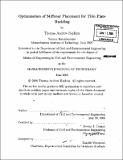| dc.contributor.advisor | Jerome J. Connor. | en_US |
| dc.contributor.author | Hopkins, Thomas Andrew | en_US |
| dc.contributor.other | Massachusetts Institute of Technology. Dept. of Civil and Environmental Engineering. | en_US |
| dc.date.accessioned | 2008-12-11T18:46:48Z | |
| dc.date.available | 2008-12-11T18:46:48Z | |
| dc.date.copyright | 2008 | en_US |
| dc.date.issued | 2008 | en_US |
| dc.identifier.uri | http://hdl.handle.net/1721.1/43892 | |
| dc.description | Thesis (M. Eng.)--Massachusetts Institute of Technology, Dept. of Civil and Environmental Engineering, 2008. | en_US |
| dc.description | Includes bibliographical references (leaf 67). | en_US |
| dc.description.abstract | Stiffened plates are a common component in many structures, from plate girders and box girder bridges to ships and offshore structures. Plates and stiffened plates buckle into doubly curved surfaces, substantially complicating the mathematics for an analytic solution. Finite element methods allow direct analysis of stiffened plates without requiring the solving of complicated differential equations. This analysis considers stiffened plates from the buoy of a tension leg platform designed to support a 5 megawatt wind turbine. The interior plates were stiffened using conventional, large, triangular, diamond and truss type stiffener arrangements. The truss scheme was designed or "tuned" specifically to the suppress the first buckling mode of the particular plate, and compared to other more arbitrary forms of material placement. The results showed that the truss stiffener that was tuned to the first mode was the most effective in increasing the critical buckling load. The truss arrangement increased the critical load by 7, 269 kips compared to 4, 180 for conventional, 2, 912 for large, 911 for triangular and 2,562 kips for a diamond stiffener arrangement. | en_US |
| dc.description.statementofresponsibility | by Thomas Andrew Hopkins. | en_US |
| dc.format.extent | 67 leaves | en_US |
| dc.language.iso | eng | en_US |
| dc.publisher | Massachusetts Institute of Technology | en_US |
| dc.rights | M.I.T. theses are protected by
copyright. They may be viewed from this source for any purpose, but
reproduction or distribution in any format is prohibited without written
permission. See provided URL for inquiries about permission. | en_US |
| dc.rights.uri | http://dspace.mit.edu/handle/1721.1/7582 | en_US |
| dc.subject | Civil and Environmental Engineering. | en_US |
| dc.title | Optimization of stiffener placement for thin plate buckling | en_US |
| dc.type | Thesis | en_US |
| dc.description.degree | M.Eng. | en_US |
| dc.contributor.department | Massachusetts Institute of Technology. Department of Civil and Environmental Engineering | |
| dc.identifier.oclc | 263685648 | en_US |
